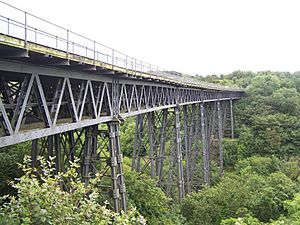Meldon Viaduct facts for kids
Quick facts for kids Meldon Viaduct |
|
|---|---|
 |
|
| Coordinates | 50°42′47″N 4°02′03″W / 50.71297°N 4.03404°W |
| Crosses | West Okement River |
| Heritage status | Scheduled Monument |
| Characteristics | |
| Material | Wrought and cast iron |
| Total length | 165 m (541 ft) |
| Height | 46 m (151 ft) |
| History | |
| Engineering design by | WR Galbraith |
| Opened | 12 October 1874 |
| Closed | 1990 |
The Meldon Viaduct is a special bridge in Devon, South West England. It crosses the West Okement River near Okehampton on Dartmoor. This bridge is unique because it's made from strong wrought iron and cast iron, not stone like many old bridges. It was built for the London and South Western Railway (LSWR) and opened in 1874. Today, trains no longer cross it. Instead, it's part of The Granite Way, a popular path for cycling and walking. The Meldon Viaduct is also a scheduled monument, meaning it's an important historical site protected by law. It's one of only two railway bridges in the UK that still uses this specific iron design.
Contents
Building the Meldon Viaduct
In the 1800s, two big railway companies, the London and South Western Railway (LSWR) and the Great Western Railway (GWR), were competing to build train lines across England. The GWR had already built a line along the south coast. This meant the LSWR, led by engineer William Galbraith, had to build their line across the higher lands of Dartmoor.
Work on the Meldon Viaduct started in 1871. It was a big project that took three years to finish. The bridge officially opened on 12 October 1874. At first, it only had one train track. This track was part of the LSWR's route to places like Plymouth and Bude.
Doubling the Tracks
In 1878, the viaduct was made wider to hold two train tracks. A second steel bridge, very similar in design, was built right next to the first one. The two bridges were then joined together. What's amazing is that they built the second line while trains were still using the first one!
To do this, they used special cranes called derricks. These cranes were placed on the original bridge. The large sections of the new bridge were put together in a railway siding. Then, two heavy cranes, which could move on rails, lifted these sections. They pushed them onto the first bridge and swung them into place. Each section could be installed in about two and a half hours. This clever method meant the railway line didn't have to close at all during the construction. The new bridge was finished in just 16 weeks.
Changes Over Time
Regular passenger trains stopped using the line in 1968. After that, the viaduct went back to having just one track. It was mainly used for moving freight trains that served a nearby quarry. In 1970, a road was built across the viaduct. This allowed lorries to reach the construction site of the Meldon Dam.
By 1990, engineers decided the viaduct was too weak for trains. So, the train tracks were removed. Six years later, in 1996, the viaduct was repaired and opened again. This time, it became part of The Granite Way, a path for cycling and walking. It is now a scheduled monument, which means it's protected as an important historical site.
Today, the Meldon Viaduct is owned by the Meldon Viaduct Company. This is a special group set up in 1999 to look after the bridge. Sometimes, people want the train line to reopen. However, experts like Network Rail say the viaduct would need to be replaced before trains could run on it again.
How the Viaduct is Designed
The Meldon Viaduct is built from wrought iron and cast iron. It's one of only two railway bridges in the United Kingdom that still uses this type of wrought iron design. The other one is the Bennerley Viaduct.
The viaduct has six main sections, called warren truss spans. Each span is about 90 feet (27 metres) long. These spans are held up by five tall, criss-cross structures called lattice trestles. The original bridge had two main supports (trusses) about 5 foot (1.5 metres) apart. When the bridge was made wider for two tracks, a second, almost identical structure was built 7 feet 6 inches (2.29 metres) away. The space between them was then covered with timber.
The main supports are about 9 feet 4 inches (2.84 metres) tall. The older ones are special because their bottom part, which takes the pulling force, is made of solid metal plates instead of a rolled beam. The trestles that hold up the bridge vary in height, from about 48 feet (15 metres) to 120 feet (37 metres). They are made of four wrought iron pillars with horizontal and diagonal supports. These trestles get narrower towards the top and sit on wide stone bases that are 24 foot (7.3 metres) across.
The entire viaduct is about 163 metres (535 feet) long. At its highest point, it rises 46 metres (151 feet) above the valley floor. The viaduct has a slight curve, and because it's in an open, windy area, trains had to cross it slowly. The speed limit was set at 20 miles per hour (32 km/h) in 1927. The trestles were made stronger in 1938 and 1944 to allow heavier trains during the Second World War. More strengthening work was done in 1959 and 1960.
See also
 In Spanish: Viaducto de Meldon para niños
In Spanish: Viaducto de Meldon para niños


